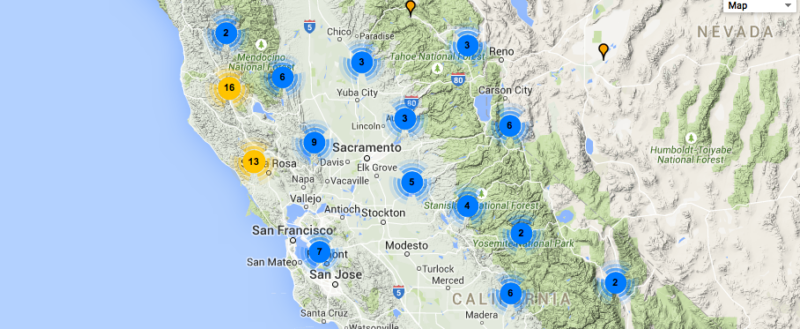Three centuries ago, the region now known as California was home to around 100 different indigenous languages, including Yurok and Karuk, Konkow and Ramaytush, Quechan and Kawaiisu. For its size, California was the most linguistically diverse area in North America.
As European settlement, disease, and violence decimated California’s native population, many tribes all but vanished—and so did their languages. Today, more than half of California Indian languages have no native speakers. Among these lost languages is Chochenyo, which was once spoken by around 2,000 people living along San Francisco’s East Bay.
UC Berkeley linguists have been documenting California’s vanishing languages for more than a century. Now, as tribes seek to educate new speakers in languages that were once thought to be lost, Berkeley’s Survey of California and Other Indian Languages (SCOIL) is digitizing thousands of field notes, manuscripts, and audio recordings in an online California Language Archive. Many of these languages have no published dictionary or grammar, which makes the archive an especially precious resource for learners.
“The material here is often unique,” says Andrew Garrett, the director of the SCOIL project.
As part of this effort, SCOIL is creating online tools for a number of specific languages. The Yurok Language Project, for example, offers a dictionary, recordings of tribal stories, and vocabulary and grammar exercises. Offline, SCOIL also hosts the biannual Breath of Life Workshop, a conference dedicated to sharing resources and knowledge related to California’s native languages.
Fertile Ground for Diverse Languages
When the Spanish arrived in the 1500s, several hundred thousand people were living in what is now California—about one-third of the Native American population of the continental United States. Tribes in close proximity to one another developed remarkably different languages. While the Konomihu language was predominant on some parts of the Salmon River, for example, New River Shasta was spoken on others.
California’s unique linguistic diversity was due to its rich microclimates, Garrett says, which allowed cultural and language communities to thrive in small areas with relatively few people. Unlike in the Great Plains, where people had to roam for resources, leading populations and languages to spread over wider territories, in California, “you could get what you wanted where you were,” Garrett explains.
Thanks to extensive trade and travel networks, however, there was still significant contact among tribes, and many native Californians spoke multiple languages. California Indian languages belong to a wide variety of families, including Athabaskan, which has speakers ranging from the Southwest to Canada and Alaska, and Yuman, centered in southern California and Western Arizona.
During the mid-nineteenth century, the Gold Rush brought some 300,000 settlers to California, igniting new hostilities and attempts at assimilation. Federal reservations set up boarding schools that forbade children from speaking their native languages. By 1900, many of these languages were near extinction.
Indian languages’ decline coincided with the rise of the new disciplines of anthropology and linguistics. In 1901, the famed anthropologist Alfred Kroeber established the Archeological and Ethnographic Survey of California at UC Berkeley. Kroeber is best known for his documentation of Ishi, the last surviving member of the Yahi tribe, who found national fame as “the last wild Indian.”
Garrett explains that Kroeber was focused on studying “pre-contact culture,” and he traveled from tribe to tribe, asking questions in English or Spanish with the help of an interpreter. In the following decades, linguists shifted to focusing more intensely on one language. The Survey of California Indian Languages was established at Berkeley in 1953.
In the late 1960s, tribes around the country began calling for cultural renewal, and focused on reviving languages that in many cases only had a few speakers remaining. In the 1980s, UC Berkeley linguist Leanne Hinton partnered with Advocates for Indigenous California Language Survival (AICLS) to create a master-apprentice program that paired remaining first-language speakers with younger learners.
“People were concerned about the language surviving, and it became part of the consciousness of the tribe that we should do something about it,” says Kayla Rae Carpenter, a UC Berkeley graduate student who studies several languages, including Hupa, Yurok, and Wailaki.
Carpenter is a member of the Hoopa Valley Tribe, based seven hours north of San Francisco. The tribe has around 3,000 members, but only a few speak Hupa as their first language. Carpenter’s great-grandmother attended the government boarding school on the reservation in the 1920s, and was forced to scrub floors as punishment for speaking Hupa. Other students were locked in a dark room for hours or days. As a result, Carpenter’s grandparents grew up speaking only English.
Still, thanks to her mother, who participated in one of the master-apprentice programs, Carpenter grew up hearing Hupa. She is now a board member of AICLS and has served as a mentor for Breath of Life workshops, which bring tribe members whose languages have few or no remaining speakers to Berkeley to conduct research projects. (Berkeley’s Leanne Hinton, who is retired, now helps lead national Breath of Life workshops in Washington, D.C.)
Together with other graduate students and native consultants, Carpenter has helped create a Hupa language website with a searchable dictionary and audio recordings with transcriptions in Hupa and English. Verdena Parker, a tribal elder who was recorded by Berkeley graduate students several years ago, recounts the traumatic violence she experienced as a young woman and how she learned to ride a motorcycle, as well as traditional stories such as how the animals were created.
Like many Indian languages, Hupa contains most of the sentence’s information in the verb. For example, the English sentence “I pick it up” can be expressed in Hupa in a single verb, yawh’awh. For her dissertation, Carpenter is creating a comparative grammar of Hupa and Wailaki. Since the latter has no remaining speakers, those wishing to learn it often refer to Hupa, which has a basic dictionary and grammar created by Berkeley graduate student Victor Golla in the 1970s.
California Language Archive
The team at SCOIL created the California Language Archive (which went online in 2011) with a grant from the National Endowment for the Humanities. This archive unites archival material that is spread across the Linguistics Department, the Bancroft Library, the Hearst Museum of Anthropology, and the Berkeley Language Center. As of Summer 2014, the total archive catalog contained 13,611 items, of which 4,652 had online digital content; new materials are regularly added.
Searchable through keywords and interactive maps, the California Language Archive includes manuscripts, audio recordings, and hundreds of scanned notebooks with linguists’ notes translating words and phrases, such as “the house is by the road” or “the house is by the creek.” A 1951 recording features native consultant Florence Shaughnessy singing a haunting love song in Yurok.
Some tribe members have used the archive to research a specific question about their language, Garrett says, while others simply wish to hear the voice of a relative who was interviewed decades ago. Recent additions include materials on Washo (spoken around Lake Tahoe) and a number of other languages, resources gathered by Berkeley linguist William H. Jacobsen beginning in 1952.
According to Garrett, the archive’s recordings reveal how some Indian languages have changed over the past century: the pronunciation of certain vowels, for example, has become more similar to that of English. To describe new technology, most tribes create terms in the language rather than using English loan words; in Yurok, the word for computer translates to “smart box,” and in Hupa, computer is described as “it writes by itself.”
According to the most recent U.S. census, California is now home to more than 723,000 Native Americans, by far the largest population of any state. Today, Indian languages are commonly taught in public schools on reservations, although funding varies from tribe to tribe. Still, even if an adult finds time to attend community classes or conduct grammar exercises online, using the language in everyday life can be difficult. The biggest challenge, Carpenter says, is “providing further support outside the school system to keep progressing.”
Garrett says that there is “much more activity” in California language restoration than there was 10 or 20 years ago. In recent years, SCOIL has expanded to include languages spoken in Central and South America. Carpenter says that interest in the Hupa language is rising among tribe members; when she teaches at the local school, more and more students have traditional names. The tribe recently received a grant for a preschool immersion program, which will help a new generation learn the sounds of their ancestors.



